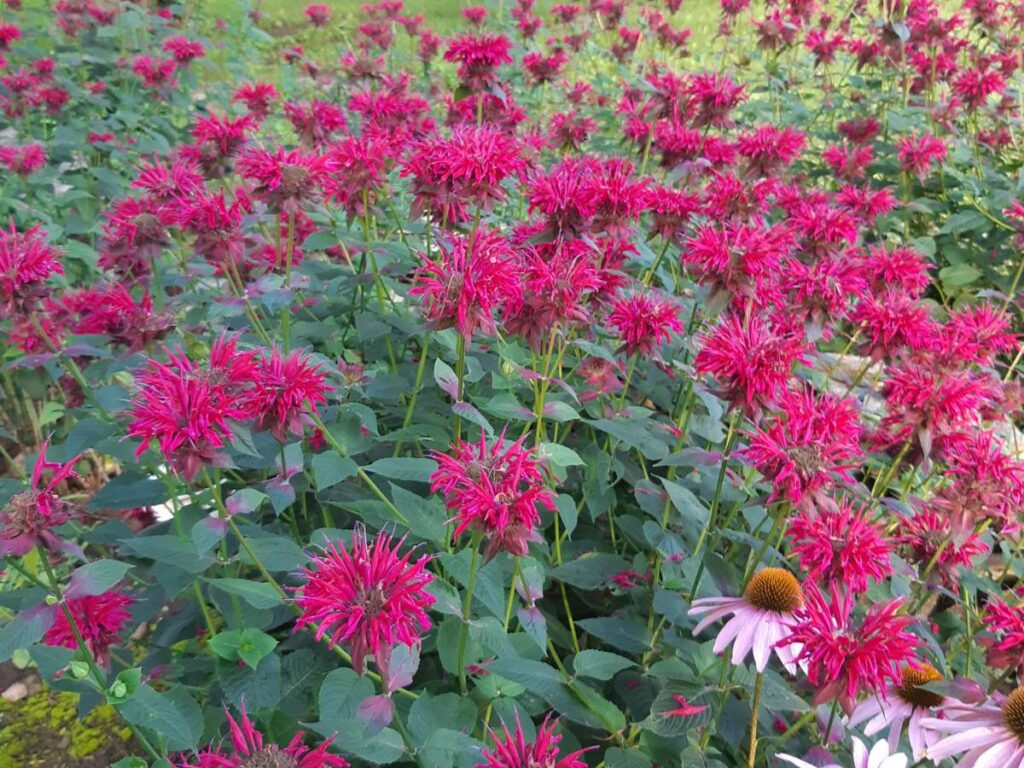Bee balm, or Monarda didyma, is a beautiful and fragrant flower that has been used for centuries in folk medicine. The plant’s leaves have anti-inflammatory properties and can be made into a tea to help with sore throats, headaches, and indigestion.
However, while bee balm may provide health benefits to humans, it’s important to note that the same cannot always be said of our canine friends. In fact, many people are unaware whether bee balm is poisonous to dogs or not.
For those who worry about their furry family members ingesting this herbaceous perennial, you’ll want to read on. This article will explore the potential side effects of exposure to bee balm for your beloved pooch, as well as offer advice on how best to handle any accidental ingestion.
We all want what’s best for our four-legged friends, so let us now take an in depth look at the potential risks associated with bee balm, starting with finding out if it really is toxic for dogs!
Here’s: Is Bee Balm Poisonous To Dogs?
Bee balm is toxic to dogs and ingestion can cause nausea, vomiting, diarrhea, possible allergic reactions and lethargy. If your dog consumes bee balm, contact a veterinarian immediately for treatment. Avoid planting bee balm in areas accessible to dogs to keep them safe.

What Is Bee Balm?
Bee balm (Monarda didyma) is a member of the mint family that has been used for its medicinal properties since the 1700s. This beautiful plant, with its colorful flowers, is also known as Oswego Tea or Wild Bergamot and is a great addition to any herb garden.
The leaves are edible and can be made into tea; however, bee balm’s main attraction are its bright red flowers, which attract pollinators in droves.
To get the most from your bee balm plants, they need full sun but will tolerate some afternoon shade. They come in a variety of colors, including pink, purple, lavender, and white—all shades of red.
Include this safe herb on your plant list, and bees will love it too! Its foliage adds texture to gardens while helping prevent weeds from taking over beds due to their lance-shaped leaves.
It’s no surprise then that these vibrant flowers have become favorites among home gardeners looking for an attractive addition and, at the same time, a natural bug repellant.
But how does bee balm affect dogs? That’s something we should explore next.
Effects Of Bee Balm On Dogs
This plant is a flowering plant found in many gardens. It has striking blooms that attract bees, butterflies, and hummingbirds to the garden. But if you have dogs at home, it’s important to consider the effects of bee balm on them. Is bee balm poisonous to dogs?
The Pet Poison Helpline states that bee balm is non-toxic for pets; however, some cases of plant poisoning may occur when excessive amounts are consumed by animals. If this happens, gastrointestinal upset or even more severe problems like kidney failure can be caused by certain alkaloids present in the plant.
Additionally, there are no medical applications for dogs where bee balm could potentially be used safely.
In spite of its potential toxicity, bee balm does not typically result in severe reactions in most animals, so long as they don’t consume large quantities of it.
That said, it’s always best to err on the side of caution and keep your furry friends away from any plants that might cause harm or discomfort. This way, you can ensure their safety while still enjoying your outdoor space!
Potential Toxicity Of Bee Balm
Bee balm has long been lauded for its medicinal properties and beauty benefits, but the potential toxicity of bee balm to our canine companions should be considered.
Dogs and cats alike can experience adverse effects when ingesting bee balm, so it’s important to know how this plant might affect your pup before you try using it for your dog.
When considering the potential toxicity of bee balm, we must look at both the edible species as well as those cultivated for ornamental purposes. All parts of most varieties are not only toxic but also cause a severe reaction in animals that consume them.
In addition to stomach distress like vomiting or diarrhea, some dogs can even suffer from neurological issues such as seizures or loss of coordination.
It’s crucial to keep any garden areas where bee balm is present away from pets that may find their way into these spaces and sample the plants, no matter how appealing they seem!
With all that said, it’s best practice to err on the side of caution when introducing new plants into an area frequented by your four-legged family members.
If you suspect that your pet has ingested any part of a bee balm plant, contact your vet immediately. Symptoms of poisoning may not appear for several hours after initial ingestion.
Symptoms Of Bee Balm Poisoning In Dogs
When it comes to symptoms of bee balm poisoning in dogs, the most common ones include vomiting, diarrhea, drooling, lethargy, loss of appetite, and skin irritation. In more severe cases, there may even be an irregular heartbeat, seizures, and metabolic acidosis.
If you suspect your pet has eaten some bee balm, then always seek veterinary attention immediately.
Understanding what causes bee balm poisoning in our beloved four-legged friends could help us ensure their safety from this potentially dangerous plant. So let’s take a look at why exactly ingestion of bee balm might lead to toxic effects.
Causes Of Bee Balm Poisoning In Dogs
When it comes to pet ownership, there are many potential pitfalls. One of these is the possibility of bee balm poisoning in dogs if they eat the wrong plant material. For some owners, this may come as a surprise – after all, who would have thought that something so seemingly innocuous could be so dangerous?
Eating the leaves or flowers can cause problems because both contain thymol which can be toxic to dogs. As with any other type of poison, the symptoms will depend on how much was eaten and how quickly medical attention was sought.
In general, ingesting bee balm can lead to vomiting, diarrhea, loss of appetite and depression in dogs. Other signs include drooling excessively and appearing lethargic or uncoordinated due to lack of balance.
Now let’s look at what steps can be taken when treating this condition.
Treatment Of Bee Balm Poisoning In Dogs
It’s easy to think of bee balm as a harmless herb, but it can be harmful if ingested by dogs. Despite this potential danger, there is hope—the treatment of bee balm poisoning in dogs is possible and has been proven successful.
If your dog ingests bee balm, then treating them should be your first priority. The most common treatments include inducing vomiting or providing activated charcoal to prevent further absorption into their system.
Your vet may also prescribe medications such as antihistamines and corticosteroids, depending on the severity of the symptoms. It’s important that you visit your vet immediately if you suspect that your pet has ingested bee balm; otherwise, they might suffer from serious medical conditions like organ damage.
In addition to medication, supportive care for an affected animal is also essential. This includes providing plenty of fluids via IVs, monitoring electrolyte levels and temperature, and supplying oxygen therapy when needed.
All these measures are necessary for a full recovery and will help alleviate any discomfort experienced by the dog due to their condition.
Prevention Of Bee Balm Poisoning In Dogs
It’s no secret that most dogs love to explore and be playful, especially when they are around the garden. It can often seem like a never-ending game of chase for our furry friends as they dig up plants, roll in grass, and generally have fun outdoors.
But it’s important to remember that some of those seemingly innocuous weeds growing around your yard could actually be harmful to their health. Bee balm is an example of one such plant.
The best way to protect your pup from these risks is by taking preventative measures before any harm takes place: make sure you know what kinds of weeds grow in your area so you can identify them quickly, and keep an eye out for any potential dangerous plants on walks with your pet.
Keep all poisonous substances away from areas where your dog might find them—including herbicides or fertilizers that contain toxic ingredients—and always supervise him when he’s out playing in the garden, just in case something unexpected pops up!
Taking these steps will help ensure that nothing unfortunate happens to your four-legged companion as he enjoys his outdoor adventures. After all, safety comes first! Now let us turn our attention towards alternatives that provide dogs with similar benefits without posing a risk of poisoning.
Bee Balm Alternatives For Dogs
When it comes to keeping our canine companions safe, prevention is key. Avoiding potential hazards that could lead to poisoning is a top priority for dog owners.
Fortunately, there are several replacement plants that provide similar health benefits without the risk of toxicity or other negative effects. Herbs such as catnip, rosemary, oregano, lemon balm, and chamomile contain natural compounds known to have health-promoting properties in both humans and animals alike.
They also lack allergenic qualities, which make them safer choices for those with allergies or sensitivities to certain plant toxins found in bee balm.
Additionally, these herbs offer subtle flavors and aromas that enhance meals and snacks while providing added nutritional value—a win-win situation!
With so many alternatives available on the market today, finding a safe yet flavor-packed herb suitable for your pup should not be too difficult an endeavor. When selecting an option, however, always remember to double check its safety rating against any known toxic plants, just in case!
When To Seek Veterinary Care For Bee Balm Poisoning In Dogs
The effects of consuming poisonous plants will vary depending on how much your dog has eaten, as well as their size. To ensure you are prepared in case of an emergency, here is a 3-point checklist:
- Monitor the symptoms – watch out for vomiting, diarrhea, difficulty breathing or walking and excessive drooling;
- Seek medical attention immediately – contact your veterinarian if you think your pup may have ingested something toxic;
- Be aware of common contraindications – although not all varieties of bee balm contain toxins that could cause harm to your canine companion, some do have alkaloids that can lead to serious illness or even death in large doses.
Conclusion
Bee balm, while beautiful and fragrant in our gardens and homes, can be detrimental to the health of our canine companions. Pet owners should take caution when growing or using bee balm; if ingested, it could lead to serious illness or even death.
The effects of bee balm poisoning on dogs can range from mild stomach upset to much more severe symptoms, such as seizures. If you think your pup has eaten bee balm, seek veterinary care immediately for a proper diagnosis and treatment plan.
As pet parents, we must remember that not all plants are safe for animals—especially those found in our gardens. My neighbor’s dog once ate some foxglove flowers from her garden and ended up at the vet with heart problems!
Just like any other potential hazards in nature, we need to stay mindful of what’s around us so that our furbabies are kept safe and healthy for years to come.







